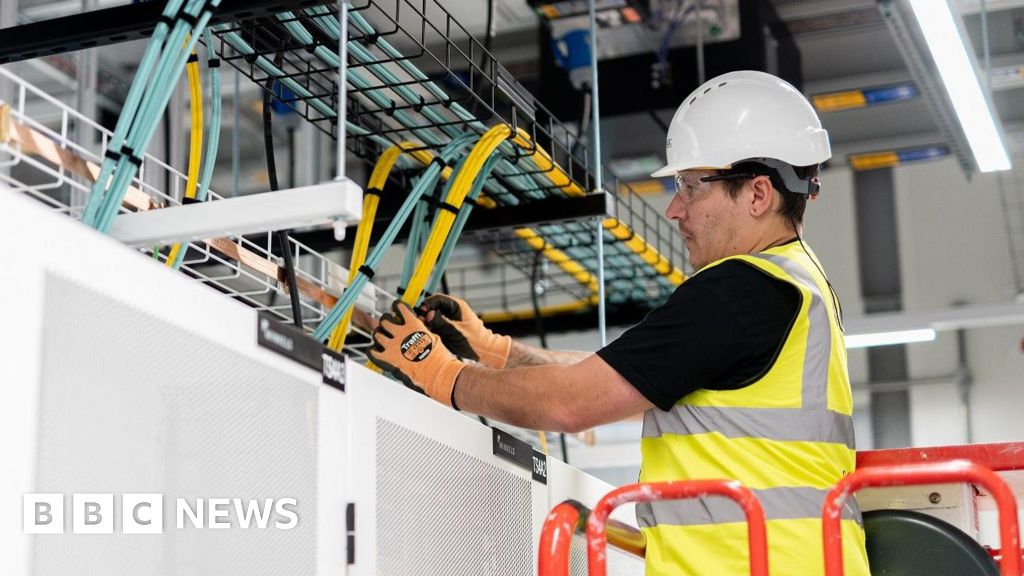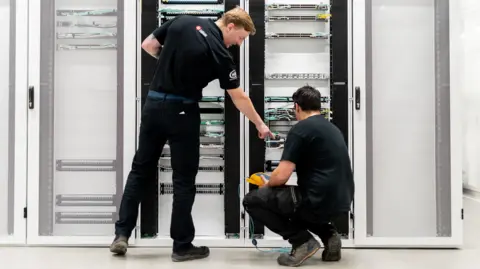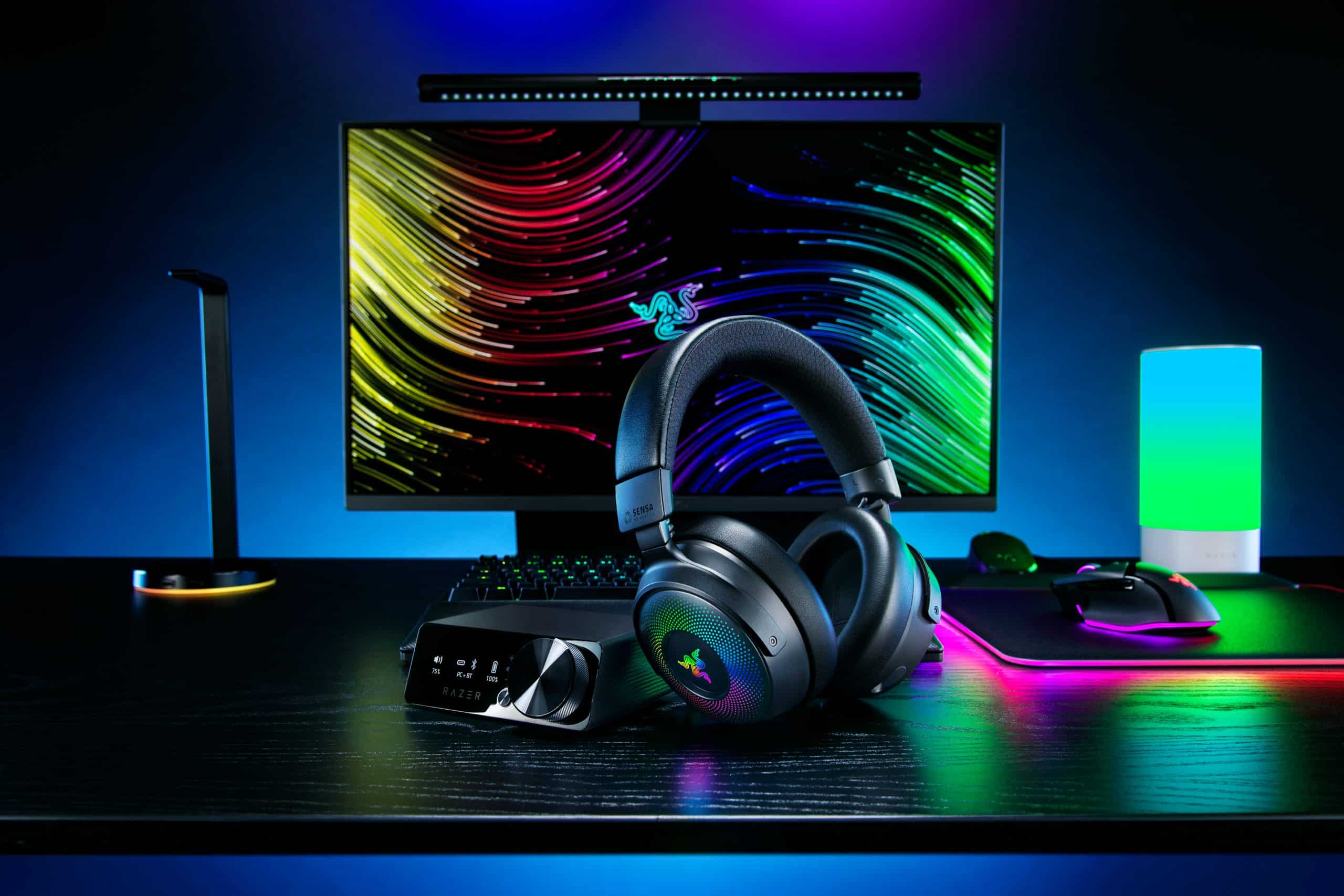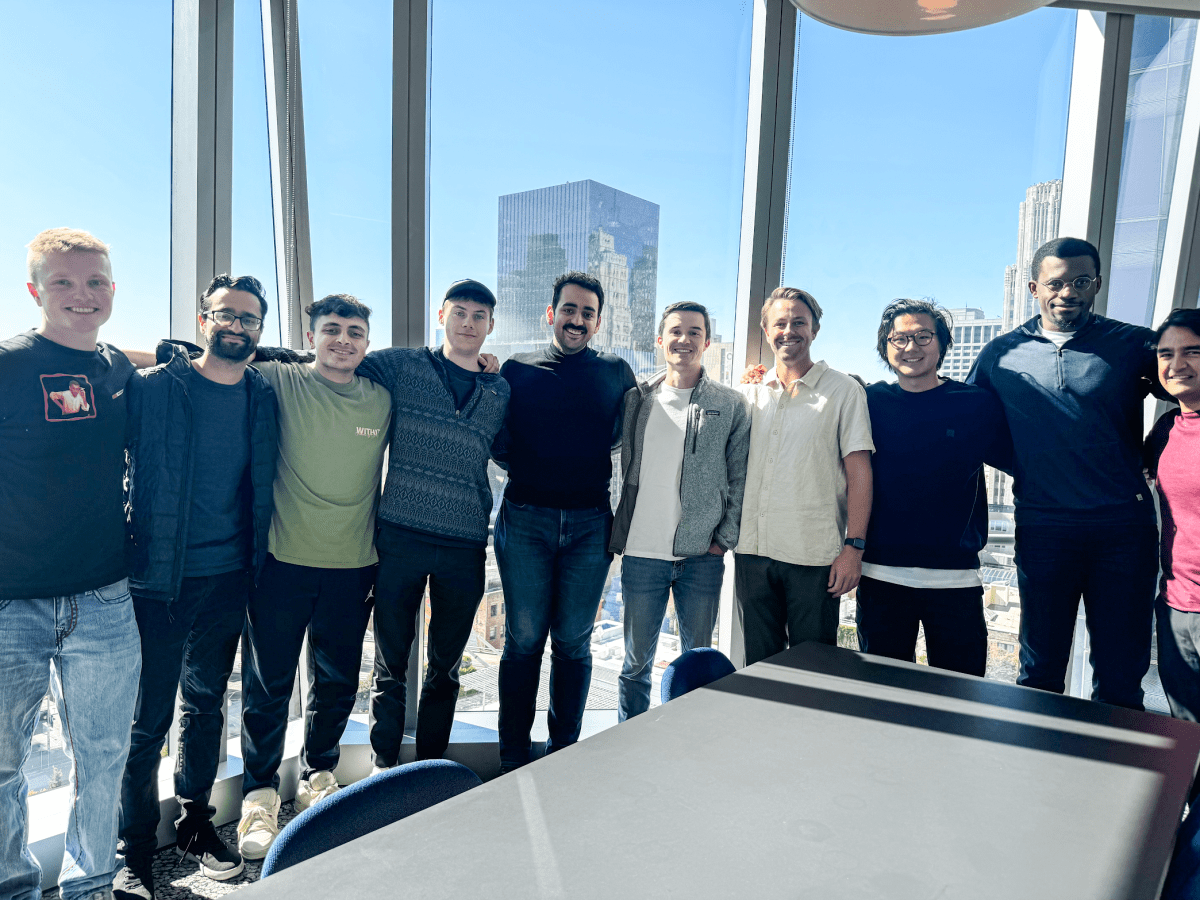Technology
Datacentre construction: Worker shortage hampers boom

 Datalec
DatalecIf someone had asked Billy Keeper five years ago what a datacentre was, he admits: “I would not have had a clue.”
The 24-year-old joined specialist electrical firm Datalec Precision Installations as a labourer straight from school.
He’s now an electrical supervisor for the UK-based firm, and oversees teams up to 40-strong carrying out electrical and cabling installations at datacentres.
This means, “managing the job, from a health and safety perspective, making sure everything goes smoothly, and dealing with the clients”.
And those clients are central to today’s technology landscape. Datacentres are the massive warehouse-like buildings from which big tech firms like Amazon, Microsoft and Facebook deliver their cloud services.
Other organisations, large and small, run their own dedicated facilities, or rely on “co-location” datacentres to host their computer equipment.
Demand for datacentre space has been turbocharged in recent years by the rise of artificial intelligence, which demands ever more high-end computers, and ever more electricity to power them.
Total datacentre floorspace across Europe was just over six million sq ft (575,418 sq m) in 2015, according to real estate firm Savills, but will hit more than 10 million sq ft this year. In London alone, datacentre “take up” in 2025 will be almost triple that of 2019, predicts real estate services firm CBRE.
But while demand is surging, says Dame Dawn Childs, chief executive of UK-based operator, Pure Data Centres Group, “delivering and satisfying that demand is challenging.”
Just finding enough land or power for new datacentres is a problem. Labour’s election manifesto promised to overhaul planning to encourage the building of infrastructure, including datacentres and the power networks they rely on.
But the industry is also struggling to find the people to build them.
“There’s just not enough skilled construction workers to go around,” says Dame Dawn.
For companies like Datalec, it’s not just a case of recruiting staff from more traditional construction sectors.
Datacentre operators – whether colocation specialists or the big tech firms – have very specific needs. “It is very, very fast. It’s very, very highly engineered,” says Datalec’s operations director (UK & Ireland), Matt Perrier-Flint.
“I’ve done commercial premises, I’ve worked in universities,” he explains. But the datacentre market is particularly regimented, he says, with everything carried out “in a calculated and structured way.”
 Pure Data Centres Group
Pure Data Centres GroupCommissioning a single piece of equipment, such as one of the chiller units that keep temperatures stable within a datacentre, will involve multiple tests and “witnessing”, Mr Perrier-Flint explains, before a final full building test, with failover scenarios.
Operators will have strict timeframes to complete a datacentre build or upgrade. At the same time, they won’t want to disrupt key business periods – ecommerce operators will typically put a freeze on any work in the runup to Christmas for example.
This can mean long days for Datalec’s teams, or even running shifts overnight.
If the demands are high, the rewards are significant too. Experienced electrical installers can make six figure salaries.
Nevertheless, companies like Datalec face a constant battle to ensure they have enough suitably qualified staff on hand.
 Datalec
DatalecThe Construction Industry Training Board predicts the UK needs to recruit 50,300 extra workers annually for the next five years. Many are concerned that the construction workforce is greying.
Dame Dawn says, “I think, along with all of the other technical industries, we’re having difficulty feeding the pipe.”
One reason for the shortfall is a focus on university education at the expense of traditional technical or apprenticeship routes in recent decades.
Mr Perrier-Flint says that when he was younger, the consensus was “you can never go wrong with a trade, you can never go wrong with construction”.
But there are more choices to tempt young people now, he suggests, including software development or other technology careers. Or indeed being an influencer on the very platforms run out of the datacentres.
Mark Yeeles, vice president, Secure Power Division, UK and Ireland, at power and automation firm Schneider Electric, began as an apprentice in the 1990s.
Given that the industry is often looking for people with 15 years’ experience, he says, “The time to start investing in apprentices was 10 years ago.”
However, Schneider Electric is changing its ratio of graduates to apprentices. “We’ve doubled our intake of apprentices,” says Mr Yeeles.
The entire industry must rethink how it recruits younger people, he adds. “My team needs to reflect the communities we’re working in,” he says, including in terms of gender, background, and experience.
And it needs to consider the career pathways it offers and recognise young people’s need for a “mission” or “purpose”. Schneider Electric, for example, has launched a sustainability apprenticeship program.
Dame Dawn agrees about the need to increase diversity and recognise recruits’ need for a mission.
“In terms of a purpose, we’re serving the whole population,” she says. “And if we could be part of the solution for net zero, then it’s serving a significant purpose, because it’s enabling humanity to drive forward.”
But perhaps the first challenge is simply explaining to potential recruits why datacentres and the cloud are central to so many facets of modern life.
As Billy Keeper says, “You try and explain to someone what the cloud is and what we offer. And they look up at the sky.”
Servers computers
Tatakan Rack Server 1U 350mm Cantilever Promo Hagane

https://www.tokopedia.com/okthastore/tatakan-rack-server-1u-350mm-cantilever-promo-hagane.
source
Technology
Razer’s Kraken V4 Pro supports simultaneous audio playback

Razer’s Kraken headset lineup has grown by one more product with the launch of the Kraken V4 Pro, which the company announced over the weekend at RazerCon alongside other products like the Freyja haptic seat cushion. The Kraken line has been around for ages at this point. Every year or two Razer releases a new generation of the headset, updating it with a few new features and improving on stuff that was already there.
This time around, Razer has kind of turned the Kraken on its head, offering what feels like the biggest shakeup for the Kraken headset lineup (and Razer) in a while – simultaneous audio playback. This might not seem like a big deal, but it’s not a very common feature. So it’s definitely more game-changing than one might assume. As it opens up the Razer Kraken V4 Pro to those who want a headset that can play audio from multiple sources at the same time.
Specifically, those who might want the game audio filtering in while listening to music from their phone. Or in my case, while chatting from the Discord mobile app. The Kraken V4 Pro accomplishes this with the help of a base station which Razer is calling the OLED Control Hub. It has ports for separate audio sources so you can connect your PC and your console. But it also allows a Bluetooth connection to play audio alongside one of those sources. I feel like this is something that Razer fans have wanted for a while. Because I know I’ve been hoping for it for years. And I can’t be the only one.
The Razer Kraken V4 Pro headset comes with Sensa HD Haptics
The inclusion of a base station and simultaneous audio playback are big features, but they’re far from the Kraken V4 Pro’s only notable one. The headset also features Razer’s Sensa HD Haptics. A feature that it launched a few years ago to beef up game immersion through audio that you can feel. Razer is trying to sell the gamer on total sensory immersion for games, and the Kraken V4 Pro seems to be a piece of that puzzle.
When you pair the headset with the use of something like the Freyja, which Razer no doubts hopes you’ll do, you get haptic feedback through the headset and the seat cushion all at once. Delivering a sensory experience in gaming that you’ve probably never imagined existed. Razer says that gamers will be able to expect a “sensory experience that blurs the lines between in-game action and reality, feeling everything from the whizz of bullets to the subtle vibrations of distant thunderstorms.”
Four modes of connectivity provide even more possibilities
Another big first for Razer headsets is the Kraken V4 Pro’s connectivity options. You already know it can link up through Bluetooth and through the use of Razer HyperSense via the OLED Control Hub. It can also connect through a wired USB cable or a wired 3.5mm audio cable. So you can use the headset with essentially anything. If your device doesn’t have a USB port or the capability to connect to the Control Hub, no worries. You can likely connect the headset through Bluetooth or the 3.5mm audio cable.
That will go a long way to convince gamers this is a headset worth spending the money on. And that’s a good thing for Razer, considering this headset’s high price. The Kraken V4 Pro will cost $399.99, making it Razer’s most expensive headset to date. It’s available as of September 28 and you can pick it up directly from Razer, or through retail partners like Best Buy or Amazon. Razer also launched the BlackWidow V4 Pro 75 earlier this month.
Technology
Songs from Adele and others are returning to YouTube as SESAC agrees to a new deal

Update, September 30, 4:30PM ET: YouTube says it has reached a deal with SESAC, and that the affected songs will be returning to the platform soon. A spokesperson sent the following comment: “We’re pleased that SESAC reconsidered our offer. We’ve reached a deal and content will come back up shortly. We appreciate everyone’s patience during this time.”
The original story, headlined “YouTube blocks songs from artists including Adele and Green Day amid licensing negotiations,” follows unedited.
Songs from popular artists have begun to disappear from YouTube as the platform’s deal with the performing rights organization SESAC (Society of European Stage Authors and Composers) approaches its expiration date. As reported by Variety, certain songs by Adele, Green Day, Bob Dylan, R.E.M., Burna Boy and other artists have been blocked in the US, though their entire catalogs aren’t necessarily affected. Videos that have been pulled, like Adele’s “Rolling in the Deep,” now just show a black screen with the message: “This video contains content from SESAC. It is not available in your country.”
In a statement to Engadget, a YouTube spokesperson said the platform has been in talks with SESAC to renew the deal, but “despite our best efforts, we were unable to reach an equitable agreement before its expiration. We take copyright very seriously and as a result, content represented by SESAC is no longer available on YouTube in the US. We are in active conversations with SESAC and are hoping to reach a new deal as soon as possible.” According to a source that spoke to Variety, however, the deal hasn’t even expired yet — it’ll reportedly terminate sometime next week — and the move on YouTube’s part may be a negotiation tactic. SESAC has not yet released a statement.
Servers computers
Rent HP Tower Server Price | HP Blade Server Rental Cost | HP Rack Server Rental India
Technology
11x.ai, a developer of AI sales reps, has raised $50M Series B led by A16Z, sources say

11x.ai, a startup that develops AI-powered sales development bots, has secured roughly $50 million in Series B funding, TechCrunch has learned. The new round was led by Andreessen Horowitz, valuing the company at around $350 million, multiple sources told TechCrunch.
The recent deal follows the company’s $24 million Series A, which was led by Benchmark with the participation of other investors including 20VC, Project A, Lux Capital, and SV Angel. While 11x.ai announced its Series A round earlier this month, we’ve learned that the deal closed earlier in 2024. The company was valued at $90 million during its Series A, according to one source.
11x.ai and Andreessen Horowitz didn’t immediately respond to a request for comment.
Hasan Sukkar, 11x’s founder and CEO, told TechCrunch that the company is approaching $10 million in annual recurring revenue. This implies that investors valued the startup at about 35 times ARR, a multiple that’s a notch more grounded than heady valuations recently garnered by other AI-powered companies with similar revenues. For example, Hebbia, a large document search startup, has raised a Series B at 54 times ARR, TechCrunch reported in July.
While Series B places 11x.ai ahead of competitors in terms of valuation and total capital, investors told TechCrunch that it’s still too early to tell whether the company has established a significant lead over its rivals. 11x.ai is one of many quickly growing startups building AI sales development representatives, or AI SDRs. Other startups working on similar solutions include Reggie.ai, AiSDR and Artisan. Incumbents such as Salesforce have also introduced products that work as autonomous sales agents.
Although some investors are wary of backing AI SDR startups because it is hard to distinguish these companies’ offerings from each other, 11x’s Series B shows that other VCs are not afraid to make a larger bet on one of these startups.
11x.ai currently has two AI bots, or what the company is calling “automated digital workers.” Alice is an AI SDR that handles sales lead generation, research and customer outreach. The company recently introduced Jordan, an AI phone sales representative that speaks over 30 languages and can handle inbound and outbound conversations with prospective human buyers.
The company told TechCrunch last year that they’re developing AI bots for talent acquisition and human resources. Now that 11x.ai has more capital, it may focus on expanding its suite of digital employees beyond just sales representatives.
Servers computers
HP ProLiant DL380 Gen7 Rack Server Overview, Specifications & Configuration

Buy Refurbished HP ProLiant DL380 G7 Rack Server …
source
-

 Womens Workouts1 week ago
Womens Workouts1 week ago3 Day Full Body Women’s Dumbbell Only Workout
-

 Technology2 weeks ago
Technology2 weeks agoWould-be reality TV contestants ‘not looking real’
-

 Science & Environment2 weeks ago
Science & Environment2 weeks ago‘Running of the bulls’ festival crowds move like charged particles
-

 News1 week ago
News1 week agoOur millionaire neighbour blocks us from using public footpath & screams at us in street.. it’s like living in a WARZONE – WordupNews
-

 Science & Environment2 weeks ago
Science & Environment2 weeks agoHow to wrap your mind around the real multiverse
-

 Science & Environment2 weeks ago
Science & Environment2 weeks agoHow to unsnarl a tangle of threads, according to physics
-

 Science & Environment2 weeks ago
Science & Environment2 weeks agoMaxwell’s demon charges quantum batteries inside of a quantum computer
-

 Science & Environment2 weeks ago
Science & Environment2 weeks agoLiquid crystals could improve quantum communication devices
-

 Science & Environment2 weeks ago
Science & Environment2 weeks agoPhysicists are grappling with their own reproducibility crisis
-

 Science & Environment2 weeks ago
Science & Environment2 weeks agoSunlight-trapping device can generate temperatures over 1000°C
-

 Science & Environment2 weeks ago
Science & Environment2 weeks agoHyperelastic gel is one of the stretchiest materials known to science
-

 Science & Environment2 weeks ago
Science & Environment2 weeks agoITER: Is the world’s biggest fusion experiment dead after new delay to 2035?
-

 News2 weeks ago
News2 weeks agoYou’re a Hypocrite, And So Am I
-

 Science & Environment2 weeks ago
Science & Environment2 weeks agoQuantum ‘supersolid’ matter stirred using magnets
-

 Sport2 weeks ago
Sport2 weeks agoJoshua vs Dubois: Chris Eubank Jr says ‘AJ’ could beat Tyson Fury and any other heavyweight in the world
-

 Science & Environment2 weeks ago
Science & Environment2 weeks agoWhy this is a golden age for life to thrive across the universe
-

 Science & Environment2 weeks ago
Science & Environment2 weeks agoQuantum forces used to automatically assemble tiny device
-

 Science & Environment2 weeks ago
Science & Environment2 weeks agoCaroline Ellison aims to duck prison sentence for role in FTX collapse
-

 Science & Environment2 weeks ago
Science & Environment2 weeks agoNuclear fusion experiment overcomes two key operating hurdles
-

 Science & Environment2 weeks ago
Science & Environment2 weeks agoLaser helps turn an electron into a coil of mass and charge
-

 Science & Environment2 weeks ago
Science & Environment2 weeks agoNerve fibres in the brain could generate quantum entanglement
-

 Science & Environment2 weeks ago
Science & Environment2 weeks agoTime travel sci-fi novel is a rip-roaringly good thought experiment
-

 News2 weeks ago
News2 weeks agoIsrael strikes Lebanese targets as Hizbollah chief warns of ‘red lines’ crossed
-

 CryptoCurrency2 weeks ago
CryptoCurrency2 weeks agoCardano founder to meet Argentina president Javier Milei
-

 Science & Environment1 week ago
Science & Environment1 week agoMeet the world's first female male model | 7.30
-

 Womens Workouts1 week ago
Womens Workouts1 week agoBest Exercises if You Want to Build a Great Physique
-

 Science & Environment2 weeks ago
Science & Environment2 weeks agoWhy we need to invoke philosophy to judge bizarre concepts in science
-

 CryptoCurrency2 weeks ago
CryptoCurrency2 weeks agoDZ Bank partners with Boerse Stuttgart for crypto trading
-

 CryptoCurrency2 weeks ago
CryptoCurrency2 weeks agoEthereum is a 'contrarian bet' into 2025, says Bitwise exec
-

 Womens Workouts1 week ago
Womens Workouts1 week agoEverything a Beginner Needs to Know About Squatting
-

 Womens Workouts1 week ago
Womens Workouts1 week ago3 Day Full Body Toning Workout for Women
-

 Science & Environment2 weeks ago
Science & Environment2 weeks agoA slight curve helps rocks make the biggest splash
-

 News2 weeks ago
News2 weeks ago▶️ Media Bias: How They Spin Attack on Hezbollah and Ignore the Reality
-

 Science & Environment2 weeks ago
Science & Environment2 weeks agoQuantum time travel: The experiment to ‘send a particle into the past’
-

 CryptoCurrency2 weeks ago
CryptoCurrency2 weeks agoBitcoin miners steamrolled after electricity thefts, exchange ‘closure’ scam: Asia Express
-

 CryptoCurrency2 weeks ago
CryptoCurrency2 weeks agoDorsey’s ‘marketplace of algorithms’ could fix social media… so why hasn’t it?
-

 CryptoCurrency2 weeks ago
CryptoCurrency2 weeks agoRedStone integrates first oracle price feeds on TON blockchain
-

 CryptoCurrency2 weeks ago
CryptoCurrency2 weeks agoBitcoin bulls target $64K BTC price hurdle as US stocks eye new record
-

 CryptoCurrency2 weeks ago
CryptoCurrency2 weeks agoBlockdaemon mulls 2026 IPO: Report
-

 News2 weeks ago
News2 weeks agoBrian Tyree Henry on voicing young Megatron, his love for villain roles
-

 CryptoCurrency2 weeks ago
CryptoCurrency2 weeks agoCoinbase’s cbBTC surges to third-largest wrapped BTC token in just one week
-

 News1 week ago
News1 week agoFour dead & 18 injured in horror mass shooting with victims ‘caught in crossfire’ as cops hunt multiple gunmen
-

 Travel7 days ago
Travel7 days agoDelta signs codeshare agreement with SAS
-

 Politics5 days ago
Politics5 days agoHope, finally? Keir Starmer’s first conference in power – podcast | News
-

 Science & Environment2 weeks ago
Science & Environment2 weeks agoBeing in two places at once could make a quantum battery charge faster
-

 Science & Environment2 weeks ago
Science & Environment2 weeks agoA new kind of experiment at the Large Hadron Collider could unravel quantum reality
-

 Science & Environment2 weeks ago
Science & Environment2 weeks agoHow one theory ties together everything we know about the universe
-

 Science & Environment2 weeks ago
Science & Environment2 weeks agoFuture of fusion: How the UK’s JET reactor paved the way for ITER
-

 Science & Environment2 weeks ago
Science & Environment2 weeks agoHow do you recycle a nuclear fusion reactor? We’re about to find out
-

 Science & Environment2 weeks ago
Science & Environment2 weeks agoTiny magnet could help measure gravity on the quantum scale
-

 CryptoCurrency2 weeks ago
CryptoCurrency2 weeks agoCrypto scammers orchestrate massive hack on X but barely made $8K
-

 CryptoCurrency2 weeks ago
CryptoCurrency2 weeks agoLow users, sex predators kill Korean metaverses, 3AC sues Terra: Asia Express
-

 CryptoCurrency2 weeks ago
CryptoCurrency2 weeks ago‘No matter how bad it gets, there’s a lot going on with NFTs’: 24 Hours of Art, NFT Creator
-

 CryptoCurrency2 weeks ago
CryptoCurrency2 weeks agoSEC asks court for four months to produce documents for Coinbase
-

 Sport2 weeks ago
Sport2 weeks agoUFC Edmonton fight card revealed, including Brandon Moreno vs. Amir Albazi headliner
-
Business2 weeks ago
How Labour donor’s largesse tarnished government’s squeaky clean image
-

 Technology2 weeks ago
Technology2 weeks agoiPhone 15 Pro Max Camera Review: Depth and Reach
-

 News2 weeks ago
News2 weeks agoBrian Tyree Henry on voicing young Megatron, his love for villain roles
-

 Womens Workouts1 week ago
Womens Workouts1 week agoHow Heat Affects Your Body During Exercise
-

 Womens Workouts1 week ago
Womens Workouts1 week agoKeep Your Goals on Track This Season
-

 Science & Environment2 weeks ago
Science & Environment2 weeks agoUK spurns European invitation to join ITER nuclear fusion project
-

 News2 weeks ago
News2 weeks agoChurch same-sex split affecting bishop appointments
-

 Technology2 weeks ago
Technology2 weeks agoFivetran targets data security by adding Hybrid Deployment
-

 CryptoCurrency2 weeks ago
CryptoCurrency2 weeks ago$12.1M fraud suspect with ‘new face’ arrested, crypto scam boiler rooms busted: Asia Express
-

 CryptoCurrency2 weeks ago
CryptoCurrency2 weeks agoDecentraland X account hacked, phishing scam targets MANA airdrop
-

 CryptoCurrency2 weeks ago
CryptoCurrency2 weeks agoCertiK Ventures discloses $45M investment plan to boost Web3
-

 CryptoCurrency2 weeks ago
CryptoCurrency2 weeks agoBeat crypto airdrop bots, Illuvium’s new features coming, PGA Tour Rise: Web3 Gamer
-

 CryptoCurrency2 weeks ago
CryptoCurrency2 weeks agoTelegram bot Banana Gun’s users drained of over $1.9M
-

 CryptoCurrency2 weeks ago
CryptoCurrency2 weeks ago‘Silly’ to shade Ethereum, the ‘Microsoft of blockchains’ — Bitwise exec
-

 CryptoCurrency2 weeks ago
CryptoCurrency2 weeks agoEthereum falls to new 42-month low vs. Bitcoin — Bottom or more pain ahead?
-
Business2 weeks ago
Thames Water seeks extension on debt terms to avoid renationalisation
-
Politics2 weeks ago
‘Appalling’ rows over Sue Gray must stop, senior ministers say | Sue Gray
-

 Science & Environment1 week ago
Science & Environment1 week agoCNN TÜRK – 🔴 Canlı Yayın ᴴᴰ – Canlı TV izle
-

 News1 week ago
News1 week agoWhy Is Everyone Excited About These Smart Insoles?
-

 News4 days ago
News4 days agoUS Newspapers Diluting Democratic Discourse with Political Bias
-

 Politics2 weeks ago
Politics2 weeks agoTrump says he will meet with Indian Prime Minister Narendra Modi next week
-

 Technology2 weeks ago
Technology2 weeks agoCan technology fix the ‘broken’ concert ticketing system?
-

 Health & fitness2 weeks ago
Health & fitness2 weeks agoThe secret to a six pack – and how to keep your washboard abs in 2022
-

 Science & Environment2 weeks ago
Science & Environment2 weeks agoSingle atoms captured morphing into quantum waves in startling image
-

 Science & Environment2 weeks ago
Science & Environment2 weeks agoHow Peter Higgs revealed the forces that hold the universe together
-

 Science & Environment2 weeks ago
Science & Environment2 weeks agoA tale of two mysteries: ghostly neutrinos and the proton decay puzzle
-

 CryptoCurrency2 weeks ago
CryptoCurrency2 weeks ago2 auditors miss $27M Penpie flaw, Pythia’s ‘claim rewards’ bug: Crypto-Sec
-

 CryptoCurrency2 weeks ago
CryptoCurrency2 weeks agoLouisiana takes first crypto payment over Bitcoin Lightning
-

 CryptoCurrency2 weeks ago
CryptoCurrency2 weeks agoJourneys: Robby Yung on Animoca’s Web3 investments, TON and the Mocaverse
-

 CryptoCurrency2 weeks ago
CryptoCurrency2 weeks ago‘Everything feels like it’s going to shit’: Peter McCormack reveals new podcast
-

 CryptoCurrency2 weeks ago
CryptoCurrency2 weeks agoSEC sues ‘fake’ crypto exchanges in first action on pig butchering scams
-

 CryptoCurrency2 weeks ago
CryptoCurrency2 weeks agoBitcoin price hits $62.6K as Fed 'crisis' move sparks US stocks warning
-

 CryptoCurrency2 weeks ago
CryptoCurrency2 weeks agoVonMises bought 60 CryptoPunks in a month before the price spiked: NFT Collector
-

 CryptoCurrency2 weeks ago
CryptoCurrency2 weeks agoVitalik tells Ethereum L2s ‘Stage 1 or GTFO’ — Who makes the cut?
-

 News2 weeks ago
News2 weeks agoBrian Tyree Henry on his love for playing villains ahead of “Transformers One” release
-

 Womens Workouts1 week ago
Womens Workouts1 week agoWhich Squat Load Position is Right For You?
-

 News1 week ago
News1 week agoBangladesh Holds the World Accountable to Secure Climate Justice
-

 TV1 week ago
TV1 week agoCNN TÜRK – 🔴 Canlı Yayın ᴴᴰ – Canlı TV izle
-

 Technology7 days ago
Technology7 days agoRobo-tuna reveals how foldable fins help the speedy fish manoeuvre
-

 Technology2 weeks ago
Technology2 weeks agoIs carbon capture an efficient way to tackle CO2?
-

 Health & fitness2 weeks ago
Health & fitness2 weeks agoThe maps that could hold the secret to curing cancer
-

 Science & Environment2 weeks ago
Science & Environment2 weeks agoThe physicist searching for quantum gravity in gravitational rainbows
-

 CryptoCurrency2 weeks ago
CryptoCurrency2 weeks agoHelp! My parents are addicted to Pi Network crypto tapper
-

 CryptoCurrency2 weeks ago
CryptoCurrency2 weeks agoCZ and Binance face new lawsuit, RFK Jr suspends campaign, and more: Hodler’s Digest Aug. 18 – 24
-

 Fashion Models2 weeks ago
Fashion Models2 weeks agoMixte



You must be logged in to post a comment Login